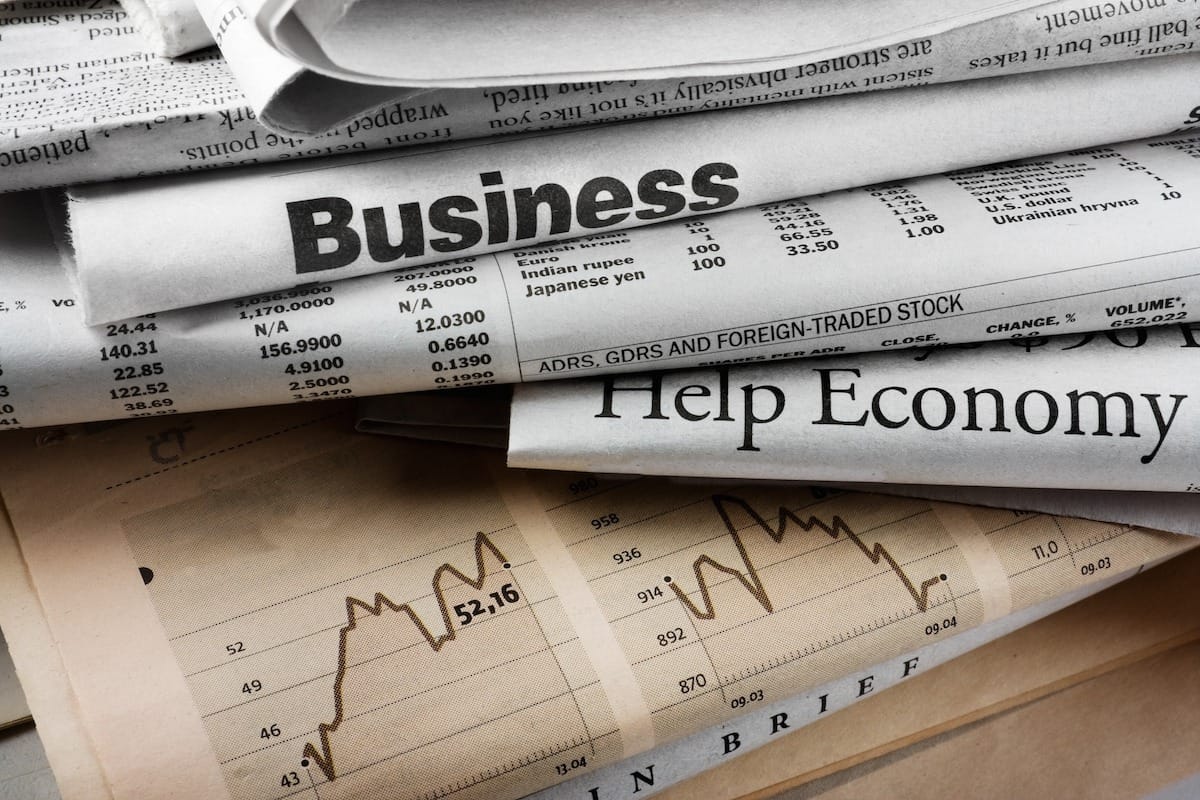Yeah, it’s almost impossible to fit everything that one might need to know about stock trading into a small article… but hey, let’s give it a try.
I’m going to keep things short and concise and address key points in order to get into the stock market and start trading. Overall, there are two parts to this – the easy and the hard part.
The easy bit involves admin and logistics behind stock trading – things like selecting a broker, opening an account and placing trades. Everyone can do this and it’s no more complicated than buying car insurance or opening a bank account.
However, what actually makes you a trader is the hard part. This involves everything about the trading process – idea generation, market research, risk management, capital allocation etc. Whole lifetimes can be (and, indeed, are) spent on this.
In this article, I’ll address both of these, although not necessarily in the same order. The action points are structured chronologically, giving you a step-by-step manual to begin trading stocks and becoming an experienced trader. I'll also give an overview of the various elements of the trading process, so that you can decide which areas to focus on and investigate next.
So… let’s do it!
1. Learn stock market fundamentals
Understanding stocks and shares
Before getting your hands dirty, it’s absolutely vital to gain some basic understanding of the products and markets that you are planning to deal with. After all, you do need to know what you are investing in, since otherwise there is no way to really understand how or why you made a profit or a loss.
Learning the fundamentals first will save you time later on and will allow you to focus on more important and interesting things in trading. It all starts with researching and learning the basics of how equity markets and products work.
Some starting questions to investigate and understand (just to name a few):
- What are stocks and what does the share price represent?
- What are the different order types? What are bid/ask/mid/last prices? What is the order book?
- How do companies report earnings and how to interpret their financial statements?
- What are analyst estimates and what are they estimating?
- Which factors impact stock prices and why?
- What is the IPO process and how does it work? What are some other ways that a company can become listed on an exchange?
- How do dividends work? What is price return and total return?
- What are corporate actions and how do they impact the shareholders?
- What are different types of stock indices, what do they represent and how can one invest in them?
- What are futures and what is their relationship with stocks and indices?
The list is not exhaustive and there are, of course, many more areas to learn and investigate. However, I’d say it’s fairly risky to invest your money without having a good understanding of the above first.

Best way to learn the basics
How you go about it largely depends on how much spare time and money you have. Most of these questions can be answered by googling, spending some time on Investopedia and reading other financial resources. Nonetheless, a more structured approach would certainly work better.
If you want to learn something quickly and don’t mind spending a bit of your hard earned cash, you can consider doing a training course. There are plenty of online ones that won’t break the bank and will give you a comprehensive overview of the stock market. Udemy and Coursera are a great resource to find these.
You can also attend a classroom training in person, but be extra careful when selecting a program. There are too many stock market courses that cost a fortune and make bold promises about the amount of success you’re going to have after completion. You certainly do not need a 12-month “Experienced Stock Trader Pro” training program if you’re just getting started and trying to learn the basics.
Whatever you do, I also personally suggest buying a finance textbook that covers all the basic bits and pieces and having a good read through it. And you can always keep it handy for future reference. In my opinion, Finance and Financial Markets by Keith Pilbeam gives a great overview of financial markets, including stocks and equities.
2. Choose an online stock broker
Ok, now that we’re equipped with some knowledge about equity markets, it’s time to open a broker account. And since no broker has agreed to sponsor this section, the choice is not so obvious.
As you’re probably aware, there are many online brokers viciously competing for your deposit money. This is actually great news, as competition (along with progress and technology) has made trading significantly cheaper and markets more accessible to regular retail investors (i.e. you and me). Barriers to entry have been lowered so much that many brokers now offer commission-free trading, zero minimum deposits and the ability to trade fractional shares.
Fantastic, so where do we go from here? First, we need to compile a list of brokers and check them against the below considerations:
Why are there so many CFD brokers in the UK? What is CFD?
If you live in UK and search for “online stock broker” you’ll find (and will probably be confused by) many brokers mentioning CFD trading when talking about shares or currencies or commodities. CFDs are Contracts For Difference and they are not the same thing as buying the stocks outright.
CFDs allow you to make a bet on the direction of the asset by paying you the difference between an asset’s price when you open and when you close the trade; times the size of the bet. For example, if you trade a CFD on a stock index, and you bet £10 per index point, you will make or lose £10 for each point that the index moves in your favor or against you.
CFDs are extremely risky products, due to the L-word: leverage. Essentially this means trading with borrowed money. For example, instead of simply investing £100 into a given stock, with a CFD contract you are effectively able to borrow an additional £900 from the broker and buy £1,000 worth of stock. In this scenario, a 10% decline in stock value would wipe out your entire deposit. A sudden 20% drop will give rise to some unpleasant conversations (and I don’t mean just with your broker).
In other words, CFDs make it possible for you to lose more than your initial deposit – something that’s impossible if you’re just buying the shares outright.
CFDs also create an extra layer between you and the market. Since these products don’t trade on exchanges, any CFD trade is only between you and your broker. The broker may not even hold the actual underlying shares against your position and can synthesize your trade by other means. As such, you are not participating in the market directly, you are not investing in a company and you don’t become a shareholder (which may be fine for some, as long as they get the desired exposure).
There are many other differences between trading through CFDs and holding shares. In the UK, for example, CFDs are treated the same way as gabling for tax purposes, which means that any profits are tax-exempt. Selling shares for profit, on the other hand, might give rise to capital gains and potentially other taxes (usual caveat applies – if required, seek independent tax advice).
As a beginner trader try to stay away from CFD contracts and CFD specialist brokers. Trade the actual markets and products instead.
Products and market access
What products and markets does the broker offer? Will you be able to invest internationally and get access to overseas markets? Does the broker specialize in stocks only or other asset classes are available as well? Is it possible to trade more complex products, such as futures and options?
Even if you’re initially interested in stocks only, the more opportunities you have, the better. For example, you may not be interested in trading currencies, but if you plan to invest in US stocks from the UK, you’ll need a way to buy some US dollars at a rate better than at your local airport.
At the very least, the broker needs to specialize in the products and markets you are planning to trade. Having said that, in this day and age, many major brokers offer comprehensive coverage and usually tick all the boxes.
Broker commissions and fees
I did mention commission-free brokers earlier, but usually that only applies to fees one pays per each trade. There are many, many other commissions that brokers charge and below are some of the examples to be aware of:
Deposit and withdrawal fees: very important to check how much the broker charges to deposit and more importantly, to withdraw money. There could be a fixed fee per transaction or something like one withdrawal per month is free, like in the case of Interactive Brokers. Also might be important to check international transaction fees if you have savings in different currencies/countries.
Management and inactivity fees: sometimes there is a fixed fee if you’re not trading (i.e. not generating enough commissions) and your money just sits there. Usually this is not much and is waived if you place a couple of trades per month.
Market data fees: this can be a big expense, depending on what markets you trade and your day job. By default, market data will not be real-time and is usually 15-minutes delayed. Since knowing prices at this instance in time is essential for trading, market data providers are able to charge fees for real-time subscriptions.
The amount of fees depends whether or not you’re a “professional” or “non-professional” subscriber. The classification is based largely on whether or not you use data for your own benefit or in a professional capacity. You can read the exact definitions here.
The difference in fees can be significant in some markets – for example, real-time data for New York Stock Exchange (NYSE) is $1.50 per month for non-professional subscribers and $23 per month for professionals (source) (and is free for anyone checking prices on Google or Yahoo finance).
Trading fees: these may indeed be zero for stocks at some brokers, but they still exist for many other instruments and products, such as futures and options. It's worth checking if you’re planning to trade more than just stocks.
Broker tools and trading platforms
Lastly, it is worth checking the trading platform provided by the broker, since this is going to be your gateway to financial markets. Some key aspects to pay attention to are as follows:
Software capabilities: What kind of analytical tools are available? Are there company events or economic calendars? News? Stock screeners? Analyst estimates? Are there any proprietary, unique features and tools?
Simplicity and ease of use: How easy is it to check commissions on your last trade? How straightforward is it to track portfolio PnL? Is it cumbersome to update your open order? Does it hang for a few seconds after every click? How’s the product search functionality?
Stability and reliability (shout out to Robinhood and Thinkorswim in the US): How many times is their system down during market hours? Are they there when you need them the most? Are there any critical bugs that interfere with the trading process?
Mobile version: incredible how you no longer need a six screen setup to trade and you can manage a portfolio with an app from anywhere with an Internet connection. Brokers’ mobile app should be as good, if not better, than their desktop application. It is worth checking what kind of capabilities and features it offers.

Not the most crucial decision
Given the above points, you can now start researching and checking available brokers against this criteria. Just to name a few, in the UK you can have a look at Interactive Brokers, Fidelity, IG, eToro, Trading 212. Readers in US also have access to such popular brokers as Robinhood, Thinkorswim and E*TRADE. (Did I miss your favorite broker? Can you suggest any other good ones? Let us know in the comments section below which ones and why).
In summary, when you’re starting up, it may be difficult to assess and thoroughly check all the features for each broker under consideration. But luckily, selecting a broker isn’t the most critical decision at this stage and it’s not big of a deal if the broker you chose is not the absolute perfect one for you. As long as it’s not terrible, you should be fine.
In my opinion it’s more important to take any broker that sort of suits you best, open an account and investigate - learn their platform, check out their tools, see what’s available, take note of things that you don’t work for you etc. Armed with this information, you can always switch to a different broker at a later stage if needed.
3. Open a live trading account with a very small deposit
As you might have noticed, I’m skipping a step with opening a paper-trading demo account and practicing there first.
Paper trading can be good if you just want to take a look at a broker’s trading platform and its features without depositing real money (although few brokers actually allow that without seeing some cash first). It’s also beneficial for testing a strategy or trying something out – i.e. in situations when you specifically do not want to make a trade with real money.
However when you’re just learning, the benefit of trading with virtual capital is also its major limitation. It’s extremely difficult to take paper trading seriously if it’s all fantasy and none of the profits and losses matter. Attitudes to risk are completely off and don’t resemble anything in real life. The amount of research and analysis you would do before allocating capital to your favorite stock will differ dramatically between $1,000 of real money and $10,000 of virtual cash. And if the position starts losing money, how motivated are you to risk manage it if it’s not real?
Hence, in my opinion, it's much more beneficial to open a real account with a small, but very real deposit, than playing around with $100,000 in paper trading.
How small is small? Well, that would certainly depend on your income and circumstances, but it needs to be small enough for you to feel completely comfortable risking it and potentially losing it. If it’s your first time at Fight Club, you have to fight trade and you’re just starting out, the initial deposit has to be much smaller than what you’re planning to invest in stocks longer-term. It needs to be small enough such that the cost of mistakes is insignificant and allows you to learn and practice.
And since you can open an account with as little as $100 and invest in fractions of shares, you won’t be at a disadvantage and will still be able to invest in those higher-priced stocks. (Of course, do confirm minimum account deposits and fractional shares features with your broker first).
4. Follow the markets and financial news
Where did the S&P 500 close today?
Like with the rest of the items below, this one doesn’t have an end-goal and is more of a continuous, long-term process. In order to develop a general market view and an intuition for how things move, it helps to follow the markets and financial news.

It doesn’t have to be extremely time consuming – at the very least, it’s worth checking how the US/European/Asian indices performed today and how the stocks in your portfolio and watch list moved.
If you have more time, explore things in greater detail and check out other markets and events as well. For example, have there been any major news announcements or economic releases today? Where is oil and gold at the moment? How did the EUR, GBP, USD trade and why? Are there any upcoming events/catalysts for tomorrow/this week/month/year etc?
Start using a stock watch list app on your phone
For a start, create a stocks watch list on your phone using any of the financial apps – the simpler, the better. I have an iPhone and a default Stocks app does the trick extremely well (does anyone know what’s the equivalent for Android?). If you’re feeling fancy, you can also try more sophisticated apps, such as Bloomberg (free, but requires a subscription for news), MarketWatch or any others.
In the stock list, add major world stock indices – S&P 500, Nasdaq, FTSE 100, DAX, Eurostoxx 50 etc. Include some major currencies (and maybe a few local ones, depending where you live). You can also track other asset classes with Exchange Traded Funds (ETFs) – these are funds that focus on a certain theme but trade like stocks. For example, you can follow US interest rates with TLT, US credit markets with HYG, gold with GLD, oil with USO etc.
And lastly, add some single stocks in the watch list too. Some of the biggest ones would be a good idea to keep an eye on, which at the time of writing are the so-called FAAMG stocks – Facebook, Amazon, Apple, Microsoft and Alphabet (i.e. Google). Throw in a Tesla or two and anything else you find interesting and worth watching.
Market data and analytics providers
Depending on the platform provided by your broker, you might want to have an additional source of market data and analytics. For example, Interactive Brokers is great for trading and placing orders, especially on mobile, but their desktop application is…. could be somewhat improved…
The leader in market data and analytics is the Bloomberg Terminal, but it’s prohibitively expensive for a great majority of retail investors. On a noble path to replace the Bloomberg Terminal are the following start-ups, which currently offer free subscriptions as they’re trying to build up their user base:
TradingView – with a big emphasis on charting and technical analysis (see the section below), TradingView covers stocks and foreign exchange.
Koyfin – provides financial data and research and in addition to stocks and currencies, has some fixed income and economics functionality as well.
Atom Finance – the focus is primarily on US stocks and equities, but they’ve got many cool features, such as a chat system, useful US pre-market digest email and many broker integration capabilities.
Yahoo Finance/Google Finance – these aren’t really standalone market analytics providers, but can also be a good source of news, analytics and data. Yahoo finance, for example, is popular among software developers who build their own analytical tools around their data.
Financial news
I won’t go too much into the details here, as many of you already know the major financial news outlets. Just to name a few – Bloomberg, Reuters, Financial Times, CNBC, Wall Street Journal, Market Watch etc. All of them can be a good source of market summaries, news, commentary, analysis and opinions.
5. Explore the macroeconomic picture
This usually goes hand in hand with following the markets. Since stocks and companies don’t exist in isolation and are part of the global economy, their share prices are impacted by the prevailing macro factors. It certainly helps to have a general picture and an idea of the current macroeconomic environment and how it may influence the financial markets in the longer-term.
Some basic things to explore here (and keep track of), include:
- How’s the economy doing at the moment? Is it growing or are we in a recession?
- What is the current level of interest rates across the world? Why? What impact do they have on currency exchange rates and other asset prices?
- What is going on with inflation? Is it low or high? Again, why? What impact will this have?
- How are things with employment? Are many people unemployed?
- What are the Central Banks up to? What policies are they pursuing at the moment and what does it mean for the markets?
- Have there been any crises recently, either global (2008 Financial Crisis, 2020 Coronavirus) or local (Eurozone Debt Crisis 2010-12)? What was the impact?
It helps to keep track of various economic data releases that are relevant to your markets and checking if the data came out above, below or in-line with economists’ forecasts. In case there was a surprise (i.e. released data significantly differs from the predictions), it’s interesting to investigate how the markets reacted. You can find an excellent calendar of upcoming major economic releases on the FXStreet website: https://www.fxstreet.com/economic-calendar
To learn more about Macroeconomics, I would recommend these two texts. For a relatively short read, have a look at Macroeconomics for Professionals by Lipschitz and Schadler. If you want to gain a more thorough and in-depth understanding, it might be worth checking out a 2019 textbook Macroeconomics by Mitchell, Wray and Watts.
6. Trade idea generation: how to find trades?
Equipped with all that knowledge, what do we do now? Generating trade ideas is probably what it all comes down to and what most full-time traders spend the majority of their time on. So how do we go about that?
Unfortunately (or fortunately, depending how you look at it), there is no single best trading idea that works all the time, in all markets. What makes trading difficult is the constant need to adapt to an ever-changing market environment, which is why it’s important to continuously re-assess your trading strategy and approach.
There are countless ways that you can trade the market and many more different trading strategies that work with varying degrees of success. In this section, I’m only going to outline the three general approaches that market participants take when trading and investing. Which one of these approaches is used depends largely on the person – their attitude, preferences and abilities. Feel free to investigate each one of these in more detail and look up different trading strategies within each category.

Fundamental analysis
Fundamental analysis focuses on the intrinsic, fundamental value of the company (or any other financial asset for that matter) and tries to identify opportunities where this fundamental value deviates significantly from the current price. The approach usually looks at the financial statements of the company, projected future cash flows, competitor metrics and many other measures. Fundamental analysts might also look at other factors such as company management, macroeconomic conditions and the industry specific issues. Big proponent of this approach is Warren Buffet and his style of investing.
Fundamental analysis is usually done with a longer-term horizon in mind and has more to do with investing, rather than trading. The idea is that the market needs time to uncover the fundamental intrinsic value. For example, if a company is currently underpriced, the market will not immediately correct this just after you placed your trade (although, I agree that would be nice). Nonetheless, it is also possible to apply fundamental analysis to short term trading – for instance, when forecasting company earnings prior to the announcement or calculating a fair share price of a new entity before a Mergers and Acquisition (M&A) deal.
One classic example of fundamental approach would be a top-down analysis. We might start with a global macro picture and identify industries that may be underperforming the rest of the market. Within those industries, we could then check if there are certain companies that are underperforming their peers for some reason. If that reason isn’t company-specific, such a company might become a good candidate for investment.
Recommended Reading:
- Principles of Corporate Finance by Brealey, Myers, Allen
- The Intelligent Investor by Benjamin Graham
- The Little Book of Common Sense Investing by John Bogle
- A Random Walk Down Wall Street by Burton Malkiel
- Irrational Exuberance by Robert J. Shiller
Technical analysis
Technical analysis involves looking at charts and trying to identify patterns based on historical data. The idea is that one can make predictions and forecasts based on previous price movements and consequently trade them.
The approach is founded on three premises:
- Everything is in the price – all news, information and anything else that might impact the price is already priced in. Hence, there is not much point in looking at anything else.
- Markets are not random and there is order to the madness (i.e. prices move in trends).
- What happened before will happen again (and hence you can forecast it).
Usually, this approach is used as a supplement to fundamental or any other form of analysis, as there might not be enough conviction to put real money on the line solely based on historical charts. Some examples and strategies of technical analysis are momentum and trend following, trading breakouts and many other candlesticks and chart patterns.
At this point, I’d like to remind everyone that there is no such thing as free lunch. While it is beneficial to be aware of certain technical indicators and metrics, please do treat this area with extreme caution, especially at the start. Technical analysis is frequently used as a tool to demonstrate how easy trading is (it’s not) and how anyone can do it (again, no, they can’t). This is typically followed up with a sales pitch for various financial products and services.
Recommended reading:
- The Art and Science of Technical Analysis by Adam Grimes
Quantitative analysis
Quantitative finance involves applying statistics, probability and software programming to financial markets. It’s a fairly broad term that is now being used for many things that involve markets, mathematics and computers.
A classical definition of quantitative finance had to do with applying probability and statistics to value complex financial contracts called derivatives. Today, anything that involves markets and complex algorithms or development of various financial tools and strategies can fall under the definition of quantitative finance.
As such, it’s not really a stand-alone analysis framework and is usually based on some other fundamental and technical premise. For example, one might want to test how profitable a given technical analysis chart pattern is and create a program that would analyze the historic profitability of such trades. Or an investor, with the help of a few smart software developers, could analyze which stock parameters result in a best performing portfolio historically.
Usually pursuing this area requires some technical skills and knowledge of a programming language, such as Python.
Recommended reading:
- Quantitative Finance by Paul Wilmott
- Trading Evolved by Andreas Clenow
- Python for Data Analysis by Wes McKinney
7. Have an additional source of income
Even though this point is at the end of the article, I cannot emphasize this enough.

By its nature, trading is a very risky business and as such, it is very unstable. Even if you’re extremely profitable and successful on average (which is already quite an achievement, congrats!), it’s still only on average. There might be some unprofitable, loss-making years and you need to have some sort of alternative income to get you through.
This idea comes back to long-term survivorship and independence. You need to be able to survive the downturns in the market and have some means to carry you through. You also need to be independent from the market volatility and not having your lifestyle depend on how the market moves.
This also explains why so many seemingly profitable and successful traders provide some sort of extra services on a side – i.e. paid newsletter subscriptions, training courses or trade sharing programs etc. More often than not, this is to generate an extra stream of income to diversify their trading activities.
Hence, unless your net worth allows you to live entirely on dividends and coupon payments, do have another source of stable income.
8. Keep learning – you are never done
Lastly, like with many things in life, there is always room for improvement. I hope this article gave you some basic understanding of where to go next and which areas to pursue. Right now it’s up to you to continue investigating, researching and simply trying out things to learn and become a better trader and investor.
I highly recommend books – they are a great resource for knowledge - and simply just doing things and testing what works for you and what doesn’t.
For any questions, or if there’s anything important or interesting I’ve missed to mention in the article – please let me know in the comments below.
I hope you enjoyed the article! We have more exciting and interesting stuff coming up, so be sure to sign up for our mailing list using the form just below.
Thank you for taking the time to read this.
All the best and good luck!






